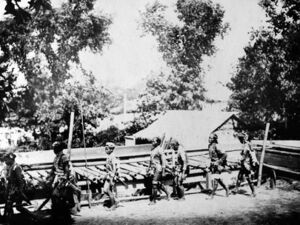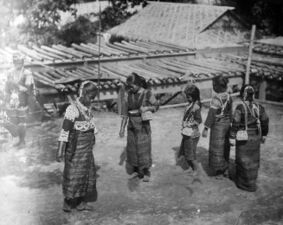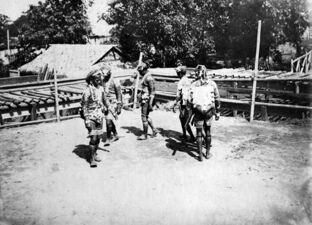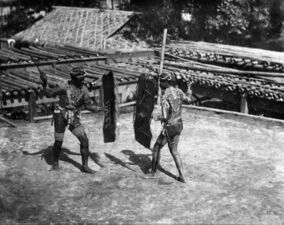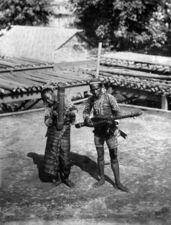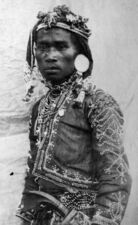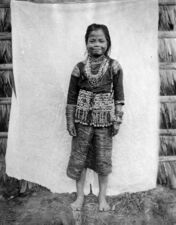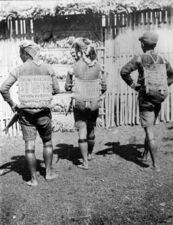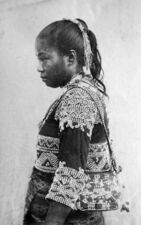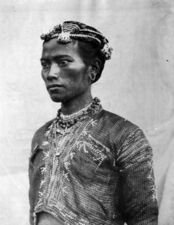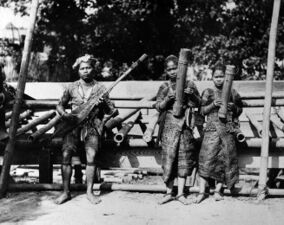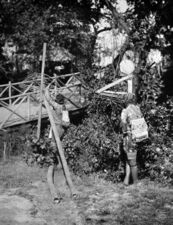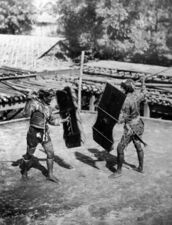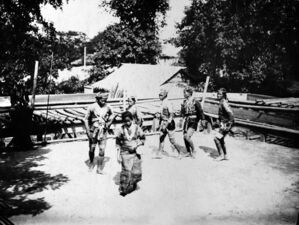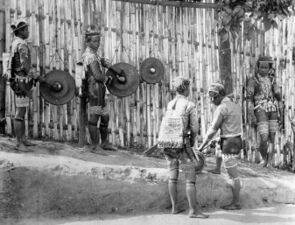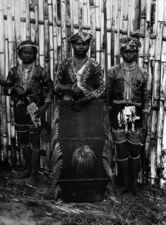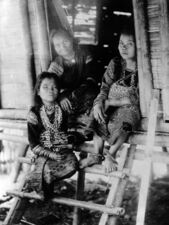Bagobo Village: Difference between revisions
No edit summary |
No edit summary |
||
| Line 39: | Line 39: | ||
At the time, the Bagobos were advertised as 'Head-hunters'. | At the time, the Bagobos were advertised as 'Head-hunters'. | ||
===Ethnology=== | |||
Two women from Chicago, Jeannette Obenchein, and Laura E Benedict lived with the Bagobo tribe within the Fair grounds. After the fair, they went on a Ethnological expedition for the Chicago Field Museum and lived with the same Bagobo tribe in the Philippines. <ref>"Filipinos Depart Fair Today." ''The St Louis Republic''. 07 Dec. 1904, p. 8.</ref> | |||
==After the Fair== | ==After the Fair== | ||
The Bagobos left the Fair on Dec 7, 1904 on a train for Seattle, eventually to said back to the Philippines. <ref>" | The Bagobos left the Fair on Dec 7, 1904 on a train for Seattle, eventually to said back to the Philippines. <ref>"Two Chicago girls live among the Bagobo at the World's Fair" ''Chicago Tribune''. 27 Nov. 1904, p. 33.</ref> | ||
==Gallery== | ==Gallery== | ||
<gallery | class="center" | mode=packed-hover | widths=150px heights=150px>> | <gallery | class="center" | mode=packed-hover | widths=150px heights=150px>> | ||
Revision as of 04:57, 29 November 2022
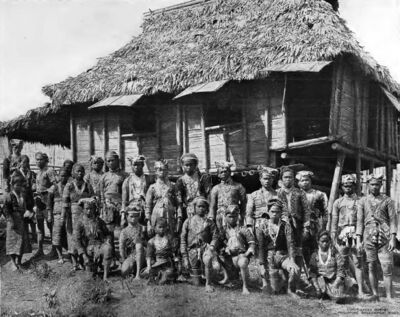 | |
| Location | Philippine Exhibit |
|---|---|
| No. of Buildings | 1 |
| Owner | C.L. Crowner |
The Bagobo Village in the Philippine Exhibit was a reservation for Bagobos, one of the largest subgroups of the Manobo peoples of the Philippines.
Before the Fair
The members of the Bagobo Village were detained several weeks at the St. Louis quarantine station on account of a case of smallpox which developed before their arrival. Their first manager, Carson Calhoun, died of the disease as did several of the natives.
Description
Forty Bagobos arrived and were given the site for a village on the Philippine Reservation. They constructed their houses in the style popular at the time.
The daily exercises in the village began at 9:30 am with the rendition of native music which was kept up throughout the day. Native dances were given every half hour, the first dance at 10 am and the last at 5pm. These dances consisted of the tribal by the men, the woman's tribal dance; a spear dance, and a bolo dance. Each performance was concluded by the introduction of Datta Bulan. An explanation of the meaning attached to the colors of the costumes worn by the different men of the tribe was given.
Upon the conclusion of the program of dances, the public was invited to inspect the native dwellings and furnishings, all of which were distinctive and characteristic of the Bagobos.
The various native traps manufactured and used by the people, consisting of a monkey trap, a chicken trap, a carabao trap, and a wild hog trap were operated and explained in detail to visitors.
The weaving of native cloths and fabrics was illustrated, explanations being given with respect to the materials, the dyes used, and the methods of securing the same.
At the time, the Bagobos were advertised as 'Head-hunters'.
Ethnology
Two women from Chicago, Jeannette Obenchein, and Laura E Benedict lived with the Bagobo tribe within the Fair grounds. After the fair, they went on a Ethnological expedition for the Chicago Field Museum and lived with the same Bagobo tribe in the Philippines. [1]
After the Fair
The Bagobos left the Fair on Dec 7, 1904 on a train for Seattle, eventually to said back to the Philippines. [2]
Gallery
-
Bulon, the Prince of the Bagobo
-
Bulon, the Prince of the Bagobo in Warrior gear
-
Ceremonial Dance
-
Dancing Girls
-
Dancing
-
Sword Duel
-
Singing Duet
-
Bagobo Family at home
-
Warrior in full dress
-
Bagobo girls
-
Bagobo displaying their hunting bags
-
A woman of the Bagobo
-
A man of the Bagobo
-
Musicians
-
Bagobo setting traps
-
The Bagobo Spear Dance
-
The Bagobo Spear Dance
-
Tribal Dance
-
Musicians at the Tribal Dance
-
Bagobo Warriors
-
Bagobo Warriors
-
Women doing bead work
-
A group of Bagobo women


